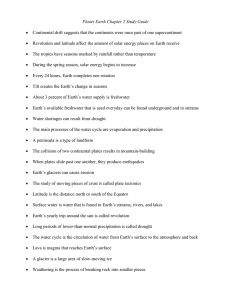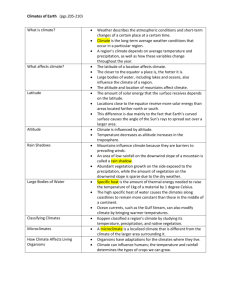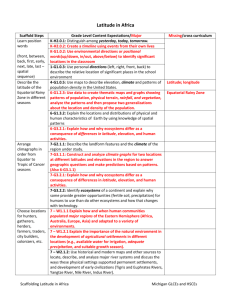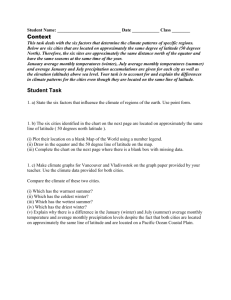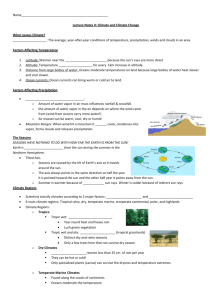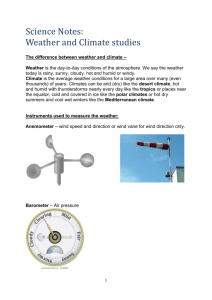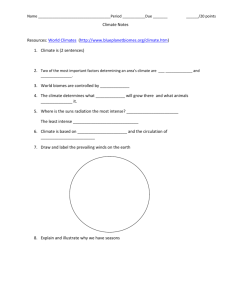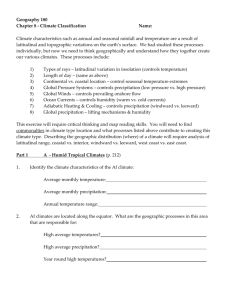Unit 3.book
advertisement
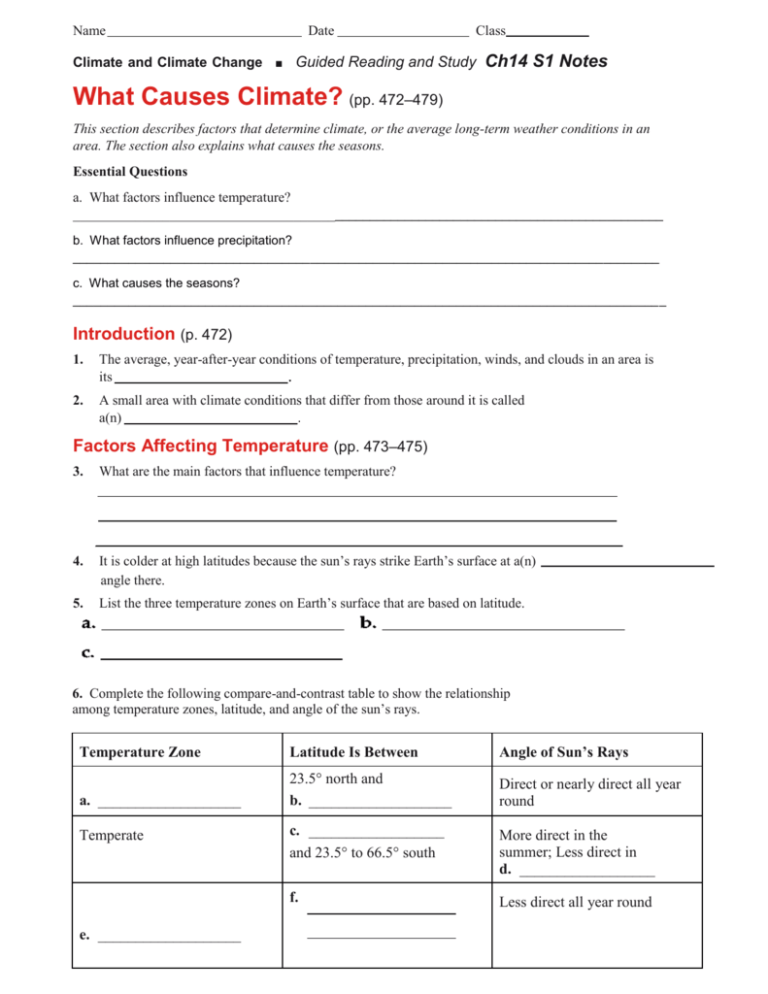
Name Date Class Climate and Climate Change ■ Guided Reading and Study Ch14 S1 Notes What Causes Climate? (pp. 472–479) This section describes factors that determine climate, or the average long-term weather conditions in an area. The section also explains what causes the seasons. Essential Questions a. What factors influence temperature? _____________________________________________________________________________________ b. What factors influence precipitation? ____________________________________________________________________________________ c. What causes the seasons? _____________________________________________________________________________________ Introduction (p. 472) 1. The average, year-after-year conditions of temperature, precipitation, winds, and clouds in an area is its 2. A small area with climate conditions that differ from those around it is called a(n) Factors Affecting Temperature (pp. 473–475) 3. What are the main factors that influence temperature? 4. It is colder at high latitudes because the sun’s rays strike Earth’s surface at a(n) angle there. 5. List the three temperature zones on Earth’s surface that are based on latitude. 6. Complete the following compare-and-contrast table to show the relationship among temperature zones, latitude, and angle of the sun’s rays. Temperature Zone Latitude Is Between Angle of Sun’s Rays a. ___________________ 23.5° north and b. ___________________ Direct or nearly direct all year round c. __________________ and 23.5° to 66.5° south More direct in the summer; Less direct in d. __________________ f. Less direct all year round Temperate e. ___________________ Ch14 S1 Notes g. Use the chart to write one or two sentences about the relationship between latitude and the angle of the sun’s rays. h. Is the climate of a temperate zone in summer more like a polar zone or a tropical zone? Use the information in the table to explain your answer. 7. Is the following sentence true or false? Areas at high altitudes have cool climates, no matter what their latitude. Match the type of climate with its description. _ Type of Climate Description 8. marine climate a. Relatively warm winters and cool summers 9. continental climate b. Cold winters and warm or hot summers 10. Circle the letter of each sentence that is true about how ocean currents influence climates. a. Ocean currents influence many marine climates. b. Only warm ocean currents influence climates. c. The North Atlantic Drift gives Ireland a warm climate for its latitude. d. The California Current gives the West Coast a warm climate for its latitude. Factors Affecting Precipitation (pp. 476–477) 11. List the main factors that affect precipitation. a. b. c. 12. Is the following sentence true or false? Winds blowing inland from oceans carry less water than winds blowing from land. 13. Circle the letter of each sentence that is true about the effect of mountain ranges on precipitation. a. Precipitation falls mainly on the leeward side of mountains. b. The windward side of mountains is in a rain shadow. c. As air rises to pass over a mountain range, its water vapor condenses, forming clouds. d. Precipitation usually falls on the side of the mountains that is hit by oncoming wind. Ch14 S1 Notes The Seasons (pp. 478–479) 14. Is the following sentence true or false? It is colder in the winter in the Northern Hemisphere because Earth is farther from the sun then. 15. When Earth is in the position shown in the drawing below, what season is it in the Northern Hemisphere? Earth Sun 16. Circle the letter of each sentence that is true about Earth’s axis. a. The axis always points in the same direction. b. The north end of the axis is tilted away from the sun all year. c. When it is summer in the Southern Hemisphere, the south end of the axis is tilted toward the sun. d. In March and September, neither end of the axis is tilted toward the sun. 17. Why is Earth’s surface warmer in the Northern Hemisphere when it is summer there?
